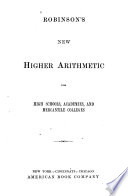 | George Edward Atwood - 1894 - 396 σελίδες
...the multiplier used. Add the partial products thus obtained. 40. To multiply by 10, 100, 1000, etc. RULE. — Annex as many ciphers to the multiplicand as there are ciphers in the multiplier. DIVISION. 41. Division is the process of separating a number into equal parts, or it is the process... | |
 | George Edward Atwood - 1894 - 214 σελίδες
...multiplier used. , Add the partial products thus obtained. 40. To multiply by 10, 100, 1000, etc. BULE. — Annex as many ciphers to the multiplicand as there are ciphers in the multiplier. DIVISION. 41. Division is the process of separating a number into equal parts, or it is the process... | |
 | John Henry Walsh - 1895 - 296 σελίδες
...figure of the multiplier that produces it. Add the partial products. To multiply by 10, 100, 1000, etc. RULE. — Annex as many ciphers to the multiplicand as there are ciphers in the multiplier. DIVISION Division is finding how many times one number is contained in another, or finding one of the... | |
 | William Frothingham Bradbury - 1895 - 398 σελίδες
...removing a figure one place to the left multiplies it by ten, two places multiplies it by a hundred, etc., to multiply by 10, 100, 1000, or 1 with any number of ciphers annexed, Rule. Move the decimal point as many places to the right as there are ciphers in the multiplier. NOTE. If... | |
 | John Henry Walsh - 1896 - 282 σελίδες
...figure of the multiplier that produces it. Add the partial products. To multiply by 10, 100, 1000, etc. RULE. — Annex as many ciphers to the multiplicand as there are ciphers in the multiplier. DIVISION Division is finding how many times one number is contained in another, or finding one of the... | |
 | Horatio Nelson Robinson - 1895 - 526 σελίδες
...number is increased one hundredfold ; and every additional cipher increases the value tenfold. HULK. — Annex as many ciphers to the multiplicand as there are ciphers in the multiplier. Multiply : 2. 364 by 100. 5. 10020 by 10000. 3. 248 by 1000. 6. 23999 by 100000. 4. 22913 by 10000.... | |
 | William Frothingham Bradbury - 1895 - 200 σελίδες
...removing a figure one place to the left multiplies it by ten, two places by a hundred, etc., therefore to multiply by 10, 100, 1000, or 1 with any number of ciphers annexed, Bule. Move the decimal point as many places to the right as there are ciphers in the multiplier. NOTE.... | |
 | John Henry Walsh - 1895 - 138 σελίδες
...multiplier that produces it. Add the partial products. To multiply by 10, 100, 1000, etc. KULE. — Annex as many ciphers to the multiplicand as there are ciphers in the multiplier. DIVISION Division is finding how many times one number is contained in another, or finding one of the... | |
 | George Edward Atwood - 1899 - 392 σελίδες
...the multiplier used. Add the partial products thus obtained. 40. To multiply by 10, 100, 1000, etc. RULE. — Annex as many ciphers to the multiplicand as there are ciphers in the multiplier. DIVISION. 41. Division is the process of separating a number into equal parts, or it is the process... | |
 | W. H. F. Henry - 1899 - 440 σελίδες
...is, by multiplying the multiplicand by one of the factors, and this product by another, and so on. 4. To multiply by 10, 100, 1000, or 1 with any number of 0's annexed, annex as many O's to the multiplicand as there are in the multiplier; or in decimals remove... | |
| |